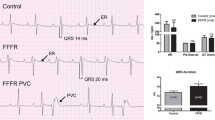Abstract
The influence of diabetes mellitus on the process of cell communication and impulse propagation was investigated in trabeculae isolated from the ventricle of diabetic rat hearts. Diabetes was produced by a single intraperitoneal injection of streptozotocin (60 mg/Kg). Cell-to-cell spread of Lucifer yellow CH was studied with the cut-end method. Measurements of the diffusion coefficient of Lucifer Yellow CH (D) was made by fitting the experimental results to theoretical points using an interactive computer program for non-linear regression. The results indicated an average value of D of 3 ± 0.8×10−7 cm2/s for the controls (n = 5) and 3.8 ± 0.5×10−8 cm2/s (n = 7) (p < 0.05) for diabetic hearts. No change of efflux of the dye through the surface cell membrane was found in diabetic rat compared to controls (p > 0.05). Moreover, the dye binding in the cytosol of diabetic heart was not significantly different from controls. The calculated values of junctional permeability for the dye was found to be p j = 1.5×10−3 cm/s for control and 1.5×10−5 cm/s for diabetic heart. To investigate the possible role of the activation of the renin–angiotensin system (RAS) on the change in cell communication, diabetic rats were treated with enalapril (25 mg/Kg/day) for a period of 14 days.
Measurements of the diffusion coefficient (D) of the dye indicated a significant increase of D (6.7 ± 1.1×10−7 cm2/s) (n = 4) (p < 0.05) compared with diabetic rats not exposed to enalapril. No change on efflux of the dye or cytoplasmic binding was found in animals treated with enalapril. The calculated value of junctional permeability showed a significant increase (p j = 3.9×10−4 cm/s) in presence of enalapril compared with controls. In addition, angiotensin II (10−8 M) added to the bath caused a significant decrease of conduction velocity in cardiac muscle of diabetic heart. In conclusion, Cell communication and impulse propagation are significantly impaired in the ventricle from diabetic rats, a phenomenon partly related to the activation of the RAS.
Similar content being viewed by others
References
Cooper ME (2004) The role of the renin–angiotensin–aldosterone system in diabetes and its vascular complications. Am J Hypertens 17:16S–20S
Chen S, Evans T, Mukherjee K, Karmazyn M, Chakrabarti S (2000) Diebetes-induced myocardial structural changes: Role of endothelin-1 and its receptors. J Mol Cell Cardiol 32:1621–1629
Burnier M, Zanchi A (2006) Blockade of the renin–angiotensin–aldosterone system: A key therapeutic strategy to reduce renal and cardiovascular events in patients with diabetes. J Hypertens 24:11–25
Machackova J, Liu X, Lukas A, Dhalla NS (2004) Renin–angiotensin blockade attenuates cardiac myofibrillar remodeling in chronic diabetes. Mol Cell Biochem 261:271–278
De Mello WC (1996) Renin angiotensin system and cell communication in the failing heart. Hypertension 27:1267–1272
Whitsel EA, Boyko EJ, Rautajardju PM, Raghunathan TE, Lin D, Pearce RM et al. (2005) Electrocardiographic QT interval prolongation and risk of primary cardiac arrest in diabetic patients. Diabetes Care 28:2045–2047
De Mello WC, van Loon P (1987) Influence of cyclic nucleotides on junctional permeability in atrial muscle. J Mol Cell Cardiol 19:83–94
Page E, McAllister LP (1973) Studies on the intercalated disk of rat left ventricular myocardial cells. J Ultrastruct Res 43:388–411
Imanaga I (1987) Cell to cell coupling studies by diffusional methods in myocardial cells. Experientia 43:1080–1083
Crespo MJ, Dunbar DC (2003) Enalapril improves vascular and cardiac function in streptozotocin diabetic rats. Cell Mol Biol 49:1311–1318
De Mello WC (1999) Cell coupling and impulse propagation in the failing heart. J Cardiovasc Electrophysiol 10:1409–1420
Rudy Y, Quan WL (1987) A model study of the effects of the discrete cellular structure on electrical propagation in cardiac tissue. Circ Res 61:815–823
Loganathan R, Bilgen M, Al-Hafez B, Smirnova IV (2006) Characterization of alterations in diabetic myocardial tissue using high resolution MRI. Int J Cardiovasc Imaging 22:81–90
De Mello WC (2004) Heart failure; how important is cellular sequestration? The role of the renin angiotensin aldosterone system. J Mol Cell Cardiol 37:431–438
Inoguchi T, Yu HY, Imamura M, Kakimoto M, Kuroki T, Maruyama T, Nawata H (2001) Altered gap junction activity in cardiovascular tissues of diabetes. Med Electron Microsc 34:86–91
Vermes E, Ducharme A, Bourassa MG, Lessard M, White M, Tardiff JC et al. (2003) Enalapril reduces the incidence of diabetes in patients with chronic heart failure: Insight from studies of left ventricular dysfunction (SOLD). Circulation 107:1291–1296
Acknowledgment
I want to thank Maria Gonzalez Castillo for technical help and grant GRS 5-S06-GM 82824 from NIH for support.
Author information
Authors and Affiliations
Corresponding author
Rights and permissions
About this article
Cite this article
De Mello, W.C. Impaired cell communication in the diabetic heart. The role of the renin angiotensin system. Mol Cell Biochem 296, 53–58 (2007). https://doi.org/10.1007/s11010-006-9297-1
Received:
Accepted:
Published:
Issue Date:
DOI: https://doi.org/10.1007/s11010-006-9297-1




